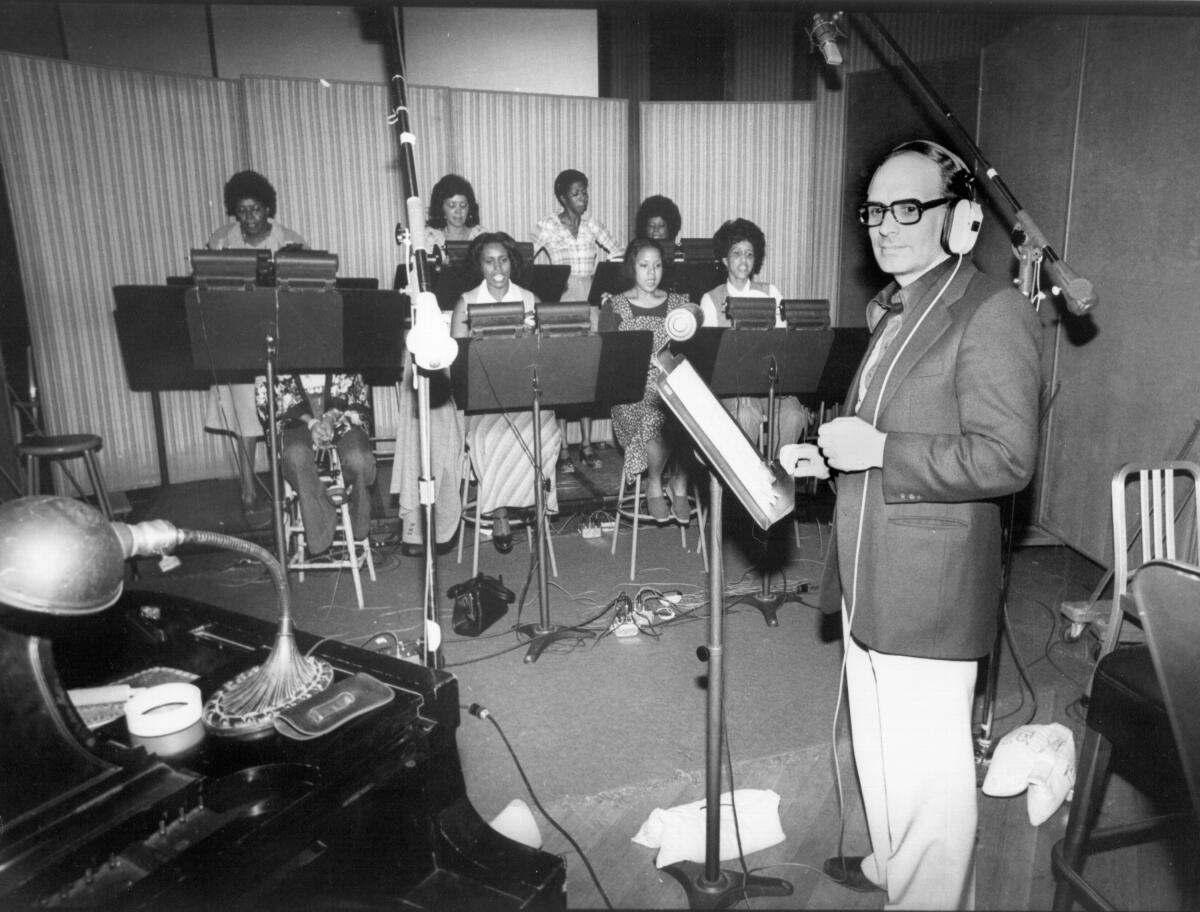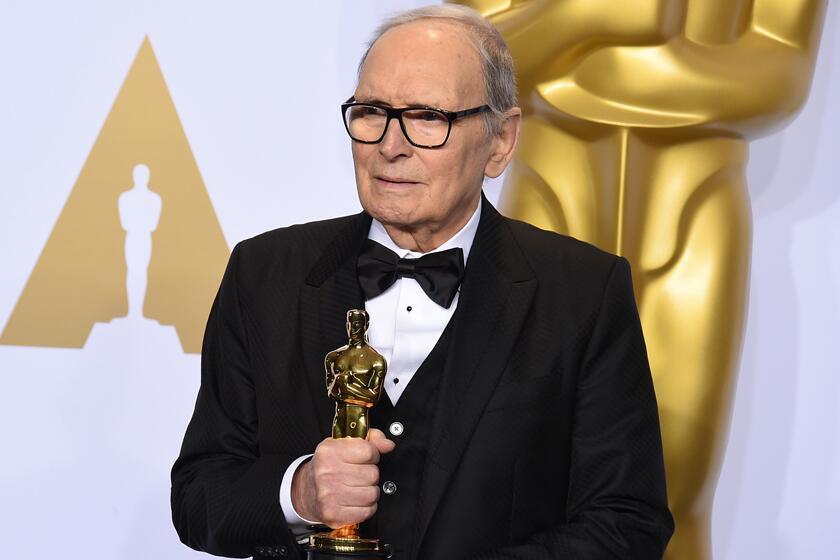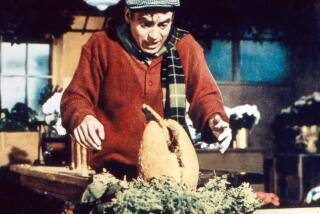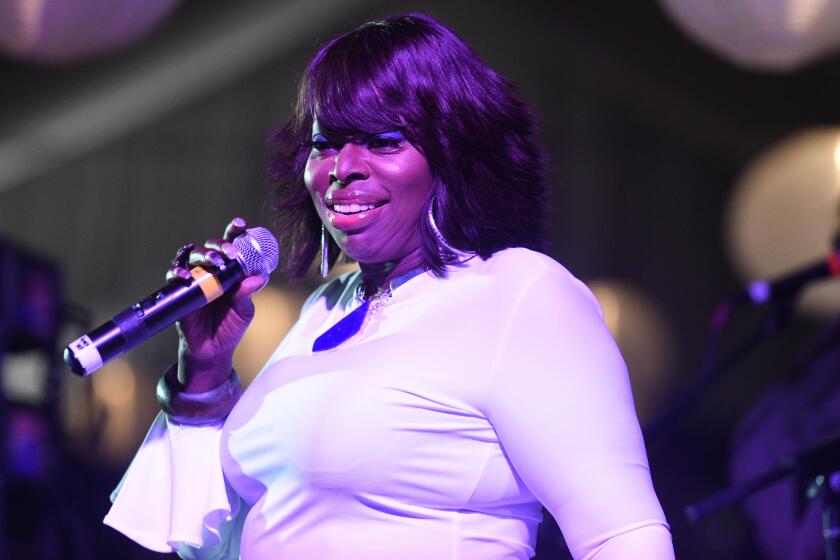Remembering Ennio Morricone: His 10 most mind-blowing film scores
- Share via
Ennio Morricone wasn’t just the most important film composer of the 20th century, he was also the busiest. Morricone, who died Monday in Rome at age 91, is best known for his early work with Italian “spaghetti western” director Sergio Leone on movies including “A Fistful of Dollars” and “The Good, the Bad and the Ugly.”
Morricone was known for his scores for such films as ‘The Mission,’ ‘A Fistful of Dollars’ and ‘The Hateful Eight,’ for which he won an Oscar in 2016.
A sublimely in-your-face composer, during his prime Morricone crafted music that went against a central tenet of the form. He didn’t offer subtle emotional guidance or heartstring-pulling obviousness. Rather, his scores added entire new layers and tones to movies. Serving as sort of whimsical, opinionated Greek chorus — one that could turn dark and sinister in a flash — his work played a co-starring role. Below, 10 essential Morricone scores.

1. “The Dollars Trilogy” (1964-1966). The trio of films Morricone made with Leone and Clint Eastwood upended film scoring much as the Beatles were upending pop music during that same period. Starting with gentle acoustic guitar backing and a whistled melody that becomes the movie’s central theme, the first minutes of the “A Fistful of Dollars” score accompany the opening credits. Setting a tone, the music gradually, gracefully builds as Morricone adds instruments one by one: a fluttering flute zips by like a sparrow, then the whip-clack of a woodblock, a faraway bell. Up we rise until a male chorus starts a chant, volume rises and the intro explodes with drama.
Both sequels, “For a Few Dollars More” and “The Good, the Bad and the Ugly,” gallop across similar terrain — harmonica and whistles galore. His theme for the latter has become sonic shorthand for “western pistol duel at sundown.” But Morricone composed for more than 500 movies in his life, and the “Dollars Trilogy” was just the beginning.

Main theme for “The Good, the Bad and the Ugly.”
2. “The Battle of Algiers” (La Battaglia di Algeri) (1966). Opening with snapping snare drums that suggest a march into war, Morricone moved away from westerns for this drama about a rebellion against French colonialism in North Africa. Collaborating on the score with his friend, the director Gillo Pontecorvo, the inventive music utilized indigenous Algerian rhythms as a way to critique the effects that colonialism had on culture. Combining European and North African musical ideas, Morricone and Pontecorvo underscored the tension that drove the conflict.

Battle of Algiers by Ennio Morricone
3. “The Big Gundown” (1968). This score is just plain weird. Full of echoed bombast and an army of timpani drums, the opening theme is as inventive a two minutes as you’ll find in film. As a pounding drum, seemingly recorded in an empty grain silo, begets more percussion, a female vocalist wails wordlessly. At times, Morricone’s orchestra burns with punk-rock intensity. Also the title of a tribute album by New York avant jazzman John Zorn, “The Big Gundown” is a wild ride. That same year, Morricone scored another western, “Il Mercenario.” It’s just as trippy.

Full score for “The Big Gundown,” by Ennio Morricone
4. “Il Gatto A Nove Code” (1971). Want to get blown away? Carve out an hour to blast Morricone’s score for director Dario Argento’s film, released in the U.S. as “Cat o’ Nine Tails.” Tossing aside all whimsy for this sinister story, the composer worked with a small group of musicians — percussion, upright bass, strings, eerie voices, piano, woodwinds, noise — to make an emotionally dense minimalist masterpiece. As a score, it’s brilliant. As a stand-alone audio experience, it’s one of the best albums of 1971. (In the below embed, check out the second track, which starts at 2:40.)

Ennior Morricone’s score for ‘The Cat o’ Nine Tails.’
5. “Novecento” (1976). Teaming with filmmaker Bernardo Bertolucci on an epic historical drama, Morricone by the mid-1970s had so distinguished himself that he seemed to revel in upending expectations. With more silence and dialog than Leone’s spaghetti westerns, “Novecento” employed Morricone sparingly. As if to make the most of his time, the composer embraced massive string sections to create a pastoral landscape similar to John Ford westerns: breathtaking, open-air orchestration almost overwhelming in its volume.

Score for Bernardo Bertolucci’s “1900.”
6. “Days of Heaven” (1978). “He didn’t know me very well, so he made suggestions,” Morricone quipped to one interviewer of his experience working on Terrence Malick’s film about a family struggling to live in the Texas panhandle prior to World War I. Notoriously stubborn, the composer met his match in Malick. The intransigence seems to have paid off: Morricone’s score earned him his first Academy Award nomination.

Ennio Morricone’s suite for “Days of Heaven.”
7. “The Thing” (1982). By the time director John Carpenter approached Morricone to work on “The Thing,” both were considered auteurs. After deciding on the score to the alien-invasion film, Carpenter, who composed his own synthesizer music for his breakout movie, “Halloween,” flew to Rome to meet with Morricone. The composer made 20 minutes of creepy orchestral music without having seen the film, and Carpenter edited this music to appear at key moments throughout. The director augmented Morricone’s score with his own synthesizer compositions. The tag-team effort has since become an archetype of the horror genre.

Ennio Morricone and John Carpenter’s theme for “The Thing.”
8. “The Mission” (1986). Featuring one of Morricone’s most breathtaking opening themes, “On Earth as It Is in Heaven,” the score for Roland Joffe’s award-winning film about a Spanish Jesuit priest’s 18th century mission to Argentina and Paraguay mixes liturgical music with tribal rhythms, conjuring ancient tones to mix with subtle orchestration. It earned him Morricone his second Oscar nomination.

Ennio Morricone, “The Mission”
9. “The Untouchables” (1987). The mid-’80s found Morricone on a stateside-run of high-profile scores. Though less playful and experimental than he was in the ‘60s and ‘70s, his work expanded further with Brian DePalma’s story of Al Capone, prohibition and the Chicago mob. Best is the film’s opening theme, which features Morricone highlighting harmonica that echoed its use in “The Dollars Trilogy,” and jerky, rat-a-tat rhythmic arrangements that drew on early jazz.

Ennio Morricone’s score for “The Untouchables.”
10. “The H8teful Eight” (2015). Morricone’s final major scoring project came at the behest of lifelong fan Quentin Tarantino and generated controversy after German Playboy incorrectly translated a Morricone interview to suggest that he called Tarantino “a cretin.” After Morricone threatened a lawsuit, the publication retracted the interview and apologized. Whatever Morricone’s feelings were on the director, he drew on his vast repertoire of ideas to create a grand, uniquely Morriconian score. The film earned him his only best score Academy Award.

Ennio Morricone’s score for “The Hateful Eight.”
More to Read
The biggest entertainment stories
Get our big stories about Hollywood, film, television, music, arts, culture and more right in your inbox as soon as they publish.
You may occasionally receive promotional content from the Los Angeles Times.












